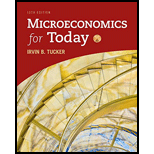
Micro Economics For Today
10th Edition
ISBN: 9781337613064
Author: Tucker, Irvin B.
Publisher: Cengage,
expand_more
expand_more
format_list_bulleted
Question
Chapter 8, Problem 11SQ
To determine
The marginal revenue per photo.
Expert Solution & Answer
Want to see the full answer?
Check out a sample textbook solution
Students have asked these similar questions
The following diagram illustrates the demand and
marginal revenue curves facing a monopoly in an industry
with no economies or diseconomies of scale. In the short
and long run, MC = ATC.
a. Calculate the values of profit, consumer surplus, and
deadweight loss, and illustrate these on the graph.
b. Repeat the calculations in part a, but now assume
the monopoly is able to practice perfect price
discrimination.
The projects under the 'Build, Build, Build' program: how these projects improve connectivity and ease of doing business in the Philippines?
how utillity relate to microeconomics ?
Chapter 8 Solutions
Micro Economics For Today
Ch. 8.5 - Prob. 1YTECh. 8.5 - Prob. 2YTECh. 8 - Prob. 1SQPCh. 8 - Prob. 2SQPCh. 8 - Prob. 3SQPCh. 8 - Prob. 4SQPCh. 8 - Prob. 5SQPCh. 8 - Prob. 6SQPCh. 8 - Prob. 7SQPCh. 8 - Prob. 8SQP
Ch. 8 - Prob. 9SQPCh. 8 - Prob. 10SQPCh. 8 - Prob. 11SQPCh. 8 - Prob. 12SQPCh. 8 - Prob. 1SQCh. 8 - Prob. 2SQCh. 8 - Prob. 3SQCh. 8 - Prob. 4SQCh. 8 - Prob. 5SQCh. 8 - Prob. 6SQCh. 8 - Prob. 7SQCh. 8 - Prob. 8SQCh. 8 - Prob. 9SQCh. 8 - Prob. 10SQCh. 8 - Prob. 11SQCh. 8 - Prob. 12SQCh. 8 - Prob. 13SQCh. 8 - Prob. 14SQCh. 8 - Prob. 15SQCh. 8 - Prob. 16SQCh. 8 - Prob. 17SQCh. 8 - Prob. 18SQCh. 8 - Prob. 19SQCh. 8 - Prob. 20SQ
Knowledge Booster
Similar questions
- How Command Economics Relate to Principle Of Economics?arrow_forwardhow commond economies relate to principle Of Economics ?arrow_forwardCritically analyse the five (5) characteristics of Ubuntu and provide examples of how they apply to the National Health Insurance (NHI) in South Africa.arrow_forward
- Critically analyse the five (5) characteristics of Ubuntu and provide examples of how they apply to the National Health Insurance (NHI) in South Africa.arrow_forwardOutline the nine (9) consumer rights as specified in the Consumer Rights Act in South Africa.arrow_forwardIn what ways could you show the attractiveness of Philippines in the form of videos/campaigns to foreign investors? Cite 10 examples.arrow_forward
- Explain the following terms and provide an example for each term: • Corruption • Fraud • Briberyarrow_forwardIn what ways could you show the attractiveness of a country in the form of videos/campaigns?arrow_forwardWith the VBS scenario in mind, debate with your own words the view that stakeholders are the primary reason why business ethics must be implemented.arrow_forward
arrow_back_ios
SEE MORE QUESTIONS
arrow_forward_ios
Recommended textbooks for you
 Managerial Economics: A Problem Solving ApproachEconomicsISBN:9781337106665Author:Luke M. Froeb, Brian T. McCann, Michael R. Ward, Mike ShorPublisher:Cengage Learning
Managerial Economics: A Problem Solving ApproachEconomicsISBN:9781337106665Author:Luke M. Froeb, Brian T. McCann, Michael R. Ward, Mike ShorPublisher:Cengage Learning
 Principles of Economics 2eEconomicsISBN:9781947172364Author:Steven A. Greenlaw; David ShapiroPublisher:OpenStax
Principles of Economics 2eEconomicsISBN:9781947172364Author:Steven A. Greenlaw; David ShapiroPublisher:OpenStax Economics (MindTap Course List)EconomicsISBN:9781337617383Author:Roger A. ArnoldPublisher:Cengage Learning
Economics (MindTap Course List)EconomicsISBN:9781337617383Author:Roger A. ArnoldPublisher:Cengage Learning

Managerial Economics: A Problem Solving Approach
Economics
ISBN:9781337106665
Author:Luke M. Froeb, Brian T. McCann, Michael R. Ward, Mike Shor
Publisher:Cengage Learning


Principles of Economics 2e
Economics
ISBN:9781947172364
Author:Steven A. Greenlaw; David Shapiro
Publisher:OpenStax

Economics (MindTap Course List)
Economics
ISBN:9781337617383
Author:Roger A. Arnold
Publisher:Cengage Learning

